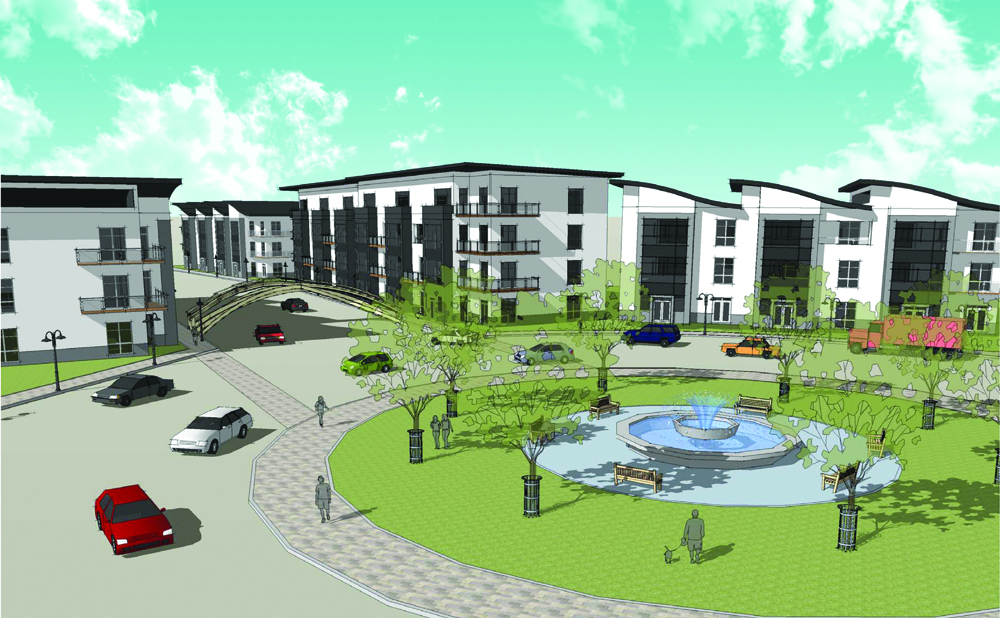If the city really wants to be a real estate developer, could we put some money to good use right here in our neighborhood?

A rendering of redevelopment opportunities at Gaston-Garland-East Grand, created by illustrator Chloe Ingram based on a conceptual idea from Norman Alston Architects
Imagine if someone walked up to you and said:
“I want to give you $100 million to transform our neighborhood, but you have to invest the money so it generates enough cash flow to pay me back.”
That’s essentially the question we posed to neighborhood resident Norman Alston of Norman Alston Architects.
But this isn’t just a money-dropping-from-the-sky scenario plucked from thin air.
Instead, this is the basic premise of revenue bonds, a term you may have heard recently in conjunction with the proposed convention center hotel, which the Dallas city council wants to build using $500 million in taxpayer-guaranteed money.
It’s not the norm for a government entity to get into the commercial real estate business — in a capitalist society, that’s usually left up to those in the private sector.
But in this case, citing longterm economic benefits for Dallas, the city council appears to be channeling real estate developers.
So if the city has decided to pour $500 million into the convention center neighborhood, what’s stopping it from spending a chunk of change here in our neighborhood?
According to council plans, revenue generated by the convention center hotel would reimburse the loan the city takes out to construct it — that’s how revenue bonds work. It’s not a novel idea: The DFW International Airport’s Grand Hyatt Hotel is one example of a privately operated project financed by public revenue bonds; another is the parking garage at Dallas Love Field. In both cases, fees paid by people booking a room or renting a parking space pay the mortgages, so to speak.
Maybe a government entity hasn’t embarked upon some sort of mixed-use, walkable, New Urbanism-style project in Dallas yet, but who’s to say it couldn’t? Or shouldn’t?
The important questions are: Would the revenues from the project be able to pay off the bonds? And would the public benefit justify the government’s financial contribution and exposure to risk?
In the case of the convention center hotel, the city believes the answer to both questions is yes. And if the city council believes it could work for the convention center, why not put taxpayer dollars behind projects in our neighborhood, right down the street from where we live?
To that end, we’ve asked leading architects and urban planners to pick an area in each of the five Dallas neighborhoods where we publish magazines (visit advocatemag.com to see the others).
Our charge: Use $100 million to create practical, neighborhood-friendly and walkable New Urbanism-style developments to help take our neighborhoods into the 21st century — exactly the kind of development the council is encouraging in Dallas these days.
A couple of caveats: We assumed that the land for this theoretical project would be acquired at a reasonable price, and we assumed the targeted land could be re-zoned, where necessary, without any complications — neither condition, of course, is a given.
Finally, we aren’t saying this is the best or the only alternative where $100 million could be spent improving our neighborhood. We aren’t saying it’s the most practical project. And we aren’t saying that having the city act as a real estate developer anywhere in the city — including Downtown — is a good idea.
But the council opened the door to this idea by committing $500 million to build a hotel Downtown, and this neighborhood proposal is certainly another option.
Here in our neighborhood, Alston devised an imaginative, forward-thinking and theoretical re-development of the intersection of Garland and Gaston roads, an area that hasn’t changed much in decades. It would fill in the gap between Lakewood and White Rock Lake, and it could feature homes for several hundred families, a redesigned streetscape that includes a traffic circle, more density, better quality construction, and new retail and office space connected by pedestrian bridges.
“This is really the only project to do when you’re thinking about these sorts of things,” Alston says. “It’s the gateway to the neighborhood and the gateway to White Rock Lake. It will enable us to enjoy White Rock Lake, because today, the only way to enjoy the lake is to be actually in it.”
Alston has focused on converting mostly empty or underused real estate into an area that would be the focus of that part of town. It includes the couple of blocks of Gaston west of Garland and the couple of blocks on either side of Gaston up and down Garland.
His goal? A mixed-use, low-rise development that fills in the Dallas skyline between the lake and Downtown, and gives residents and shoppers a view of the lake.
The new development would include:
• Five to six stories of mixed-use development, with 200 units of housing and about 250,000 square feet of retail and office space. The housing would be priced and designed to target a variety of demographics, including lofts and townhomes.
• High-quality construction and re-using and re-adapting current buildings. The goal is that the housing, office and retail would last decades, increasing the price of building in the short term, but hopefully providing developers with more profit in the long run. And Alston’s project would include space for the White Rock YMCA, which is located at the intersection.
• A redesigned, more efficient streetscape. The intersection would be reworked, replacing the traffic lights with a traffic circle. Alston says the traffic circle would slow down — but not stop — traffic, and improve flow. It would also change the focus of the intersection from a throughway between neighborhoods to being a part of the neighborhood. In addition, side streets would curve in and out of the development.
• That means no parking lots as we know them. The former parking lots, meanwhile, would have buildings and parks on them. Visitors would park on the streets and perhaps in a small garage. Providing parking can cost as much as 20 percent of a project for land that doesn’t generate any revenue.
• Two pedestrian bridges would go over Gaston, allowing residents and shoppers to walk between the development without having to brave the traffic.
This version of a re-developed Garland and Gaston is possible today, and Alston believes that it could cost about $100 million.
What’s lacking appears to be the vision and leadership to make it possible. According to individual council members, not even a “yes” vote on the May 9 convention center hotel referendum (a “yes” vote is a vote against the hotel) will stop the city from spending $500 million to build the hotel, so clearly the council is willing to jump into the commercial real estate development business.
And that’s why we thought the council might want to consider an alternative or an addition to their plans: Maybe we should begin a similar conversation about using revenue bonds to spur neighborhood-appropriate development — like Alston’s theoretical Gaston and Garland project — throughout the city.







